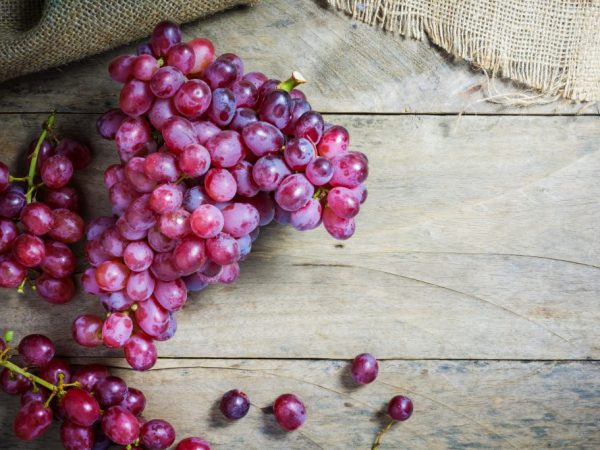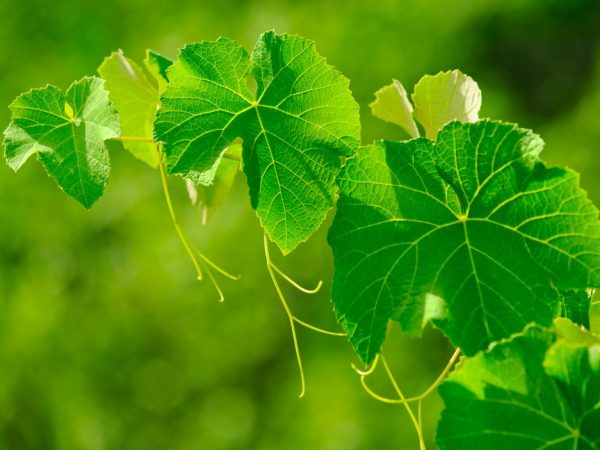Description of Shahinya grapes of Iran
The sweet Shahinya grape of Iran is a table hybrid species. The ripening period is early - it bears fruit already in early August. From the beginning of blooming to technical maturity, 120-130 days pass.

Description of Shahinya grapes of Iran
Characteristics of the variety
One of the advantages of the variety is frost resistance. Shahinya Iran can withstand temperature drops up to - 21 ° C. Thanks to this, it lends itself to long-term transportation. Bunches can be stored in a cold room for up to 2 months.
The disadvantage of the Shahinya grape variety of Iran is its low resistance to diseases. Any mistake in leaving will result in an infection of the bush.
Description of the bush
The Shahinya grape variety of Iran has a vigorous bush. Reaches a height of 3-5 m.
The grape yield is high. One bunch weighs between 0.8 and 1 kg.
Description of the bunch:
- average density;
- cylindrical-rectangular shape;
- friability is small.
The berries stick tightly to the bunch. But if they overripe, they easily break off, sometimes even fall off. Peat irrigation is rare, once every 4-5 years due to poor climatic conditions.
Description of fruits
Shahini berries of Iran are large - about 10 g, for 1 cluster there are about 100 pieces. The size of the berry is 3.5 * 2.5 cm.
Features of the fruit:
- the peel is thick, does not crack when the temperature changes;
- oval shape, elongated, sometimes round;
- deep purple color with a reddish tint;
- the pulp is juicy, dense, fleshy;
- few seeds - 2-3 pieces in one berry.
The taste of the berries is sweet. Sugar makes up 18% of the total weight (calculated per 100 grams).
Shahinya Iranian grapes are great for sweet red wines. They can be used for making jams, confitures, preserves. They are added to homemade compotes.
Growing grapes
The variety is grown only in the southern regions. He loves warmth, so he rarely takes root in the northern regions. At low temperatures, it gives few yields of poor quality.
Landing in the soil

Grapes do not tolerate drafts
For disembarkation, choose the sunny side (usually the south side of the site). It is important that there are no drafts, because strong gusts of wind can damage the bush.
For Shahini Iran, black soil is perfect. It contains the required amount of minerals. Alternatively, poor soils are taken, but they must be pre-treated. Fertilized with mineral and organic ingredients.
This type of grape should be planted in autumn or spring. To do this, you need to purchase a seedling and plant it before budding in early August. In autumn, the optimal time for planting is October 15-25.
The size of the planting pit is adapted to the root system of the bush. On average, it should be 1 * 1 m in size. A layer of crushed stone (5-6 cm) is poured, then a layer of manure (5 cm). The disembarkation is done only 2 weeks after such procedures.
Having planted a bush, it is covered with earth to the root collar. Then pour a bucket of warm water. Easily trample the ground around.
Plant care
The care of this type of grape is traditional. Consists of timely watering, fertilizing and weed removal.
The Shahinya of Iran requires good lighting. If the bush is in the shade for more than 1 hour during the daytime, the yield will decrease.
Other care procedures:
- The optimum temperature for growing is from 20 ° C during the day, from 10 ° C at night.
- It is important to loosen the soil around the grapes once a week and remove weeds. They can damage the roots, which will affect the fruiting of the plant.
- Pruning is carried out if necessary. Most often - to remove dried or frozen branches. The purpose of pruning is to rejuvenate the plant.
Fertilizer
Top dressing is applied in spring, summer and autumn. In the spring season, mineral fertilizers are applied. They must necessarily contain nitrogen and phosphorus - it is better to have less potassium. Superphosphate is added first. It will take 40 g of substance per 1 sq. M.
Nitrogen is introduced in mid-May. It is found in manure and chicken droppings. Fertilizer preparation:
- Take manure or droppings and mix with water in a 1: 2 ratio.
- Let it brew for 6 hours.
- Water the bush, taking into account the consumption rate of 1:10. For 1 plant, 1 liter of solution is enough.
Potash fertilizers are applied in June. They will improve yields and affect the palatability of the fruit.
Watering
It is better to water the grapes early in the morning or late in the evening. The number of waterings per week is 2, sometimes 3 if it is hot. It is better to use drip irrigation every 7 days to moisturize the leaves and fruits.
Fight disease
According to the description, the Shahinya grape variety of Iran is often affected by fungal and bacterial infections. The most common is powdery mildew or powdery mildew. Under its influence, the leaves become curly, the fruits are covered with gray fluff. A white bloom appears on the leaf plate. Gradually, the plant dries up and dies off.
To fight powdery mildew will help:
- Horus;
- Speed;
- Strobe.
The Shahinya of Iran is sometimes struck by anthracnose. As a result, black spots appear on the berries, which grow and can occupy the entire space of the fruit. The leaves turn yellow at the edges and fall off. To combat such a fungal disease, fungicides are used - Antrakol, Acrobat, Cuprosat, Ridomil, Thanos, Horus. A 3% Bordeaux mixture will also help.
Conclusion
Shahinya grapes of Iran are popular due to the bright appearance of the fruit and excellent taste. The main advantages are resistance to frost, ease of growing, the ability to transport crops. Among the shortcomings, there is a weak resistance to pests and diseases, as a result of which the level of yield and quality of fruits decreases.

